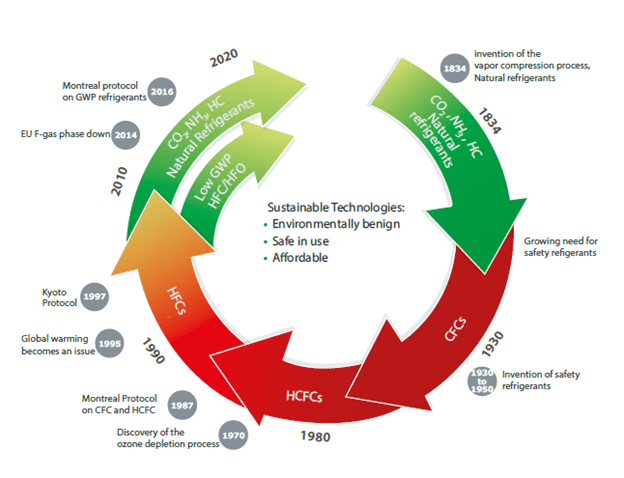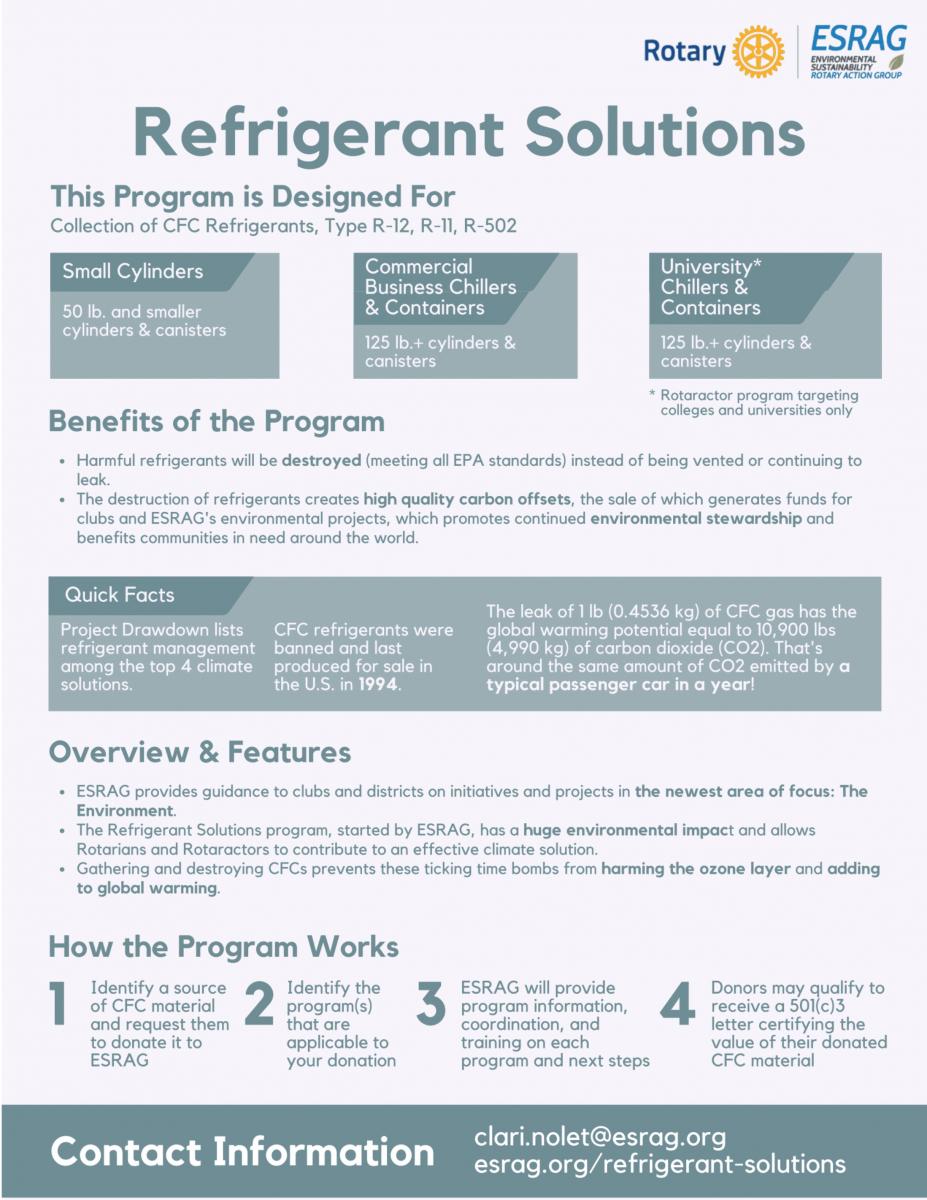ESRAG INITIATIVE
Refrigerant Solutions
Reversing Global Warming by preventing powerful
Green House Gases from escaping into the atmosphere.
WHAT IS IT?
Refrigerant Solutions
Global warming and stratospheric ozone depletion pose grave threats to life on earth. Chlorofluorocarbons (known as CFCs and widely recognized by Dupont’s trademarked name Freon®) have been used globally as refrigerants and are particularly potent ozone depleting substances (ODS) and greenhouse gases (GHGs).
As a result, manufacturing CFCs and new equipment that utilize them have been banned. Nonetheless, aging stores of CFCs remain present around the world. We want obsolete CFCs collected and destroyed to prevent them from contributing to ozone depletion and global warming.
REFRIGERANT SOLUTIONS
Featured Webinar
INITIATIVES
Why we should care
CFCs were developed in the 1930s to provide a safer alternative to the flammable and toxic refrigerants, such as CO2, ammonia (NH3), and Hydrocarbons (HCs), then in use. Unintended consequences of the chemical structure of CFCs include their depleting stratospheric ozone and remaining in the atmosphere for hundreds of years as destructive greenhouse gases GHGs.
Ozone depletion leads to increases in UV-B radiation reaching earth, causing damage to plants and terrestrial ecosystems, as well as animals—including humans—and marine life. The negative impact includes skin cancer, eye damage, crop failure and coral bleaching. The Montreal Protocol (1989) is a global agreement to protect the stratospheric ozone layer by phasing out the production and consumption of ozone-depleting substances (ODS), starting with CFCs. In 1990, the Montreal Protocol was strengthened to ban the use of CFCs altogether in industrialized countries by the year 2000 and by 2010 in developing countries. In addition, scientists discovered that CFCs are a significant contributor to global warming.

Background Information
CFC refrigerants were banned in response to their adverse impact on the stratospheric ozone layer and their high Global Warming Potential (GWP). GWP is a measure developed to allow comparisons of the global warming impacts of different gases. Specifically, GWP measures how much energy the emissions of 1 ton of a particular gas will absorb over a given period of time (the measurement time period for GWP is 100 years), relative to the energy absorption of the emissions of 1 ton of carbon dioxide (CO2). The larger the GWP, the more that a given gas warms the Earth compared to an equivalent weight of CO2 over that time period. Other gases relative contribution to global warming vis-à-vis CO2 is described in terms of CO2 equivalents (CO2e).
The leak of one pound (.4536 kgs) of CFC-12 gas has the GWP equal to 10,900 pounds (4,990 kgs) of carbon dioxide (CO2), or approximately the same amount of CO2 emitted by a typical passenger car in a year.
Even though CFCs have been banned, the remaining stockpiles of cylinders and canisters, along with CFCs leaking from old and obsolete equipment, remain a major threat to both global warming and stratospheric ozone depletion. A recent MIT study calculates that continued emissions from stored CFCs has the GWP of 9 billion metric tons of carbon dioxide. For reference, that exceeds the total amount of GHGs the European Union pledged to eliminate from 2019 to 2030 to meet their commitment under the Paris Climate Accord. In addition, the CFCs if released could also the delay Antarctic ozone hole recovery by about six years.
The Increasing global demand for refrigeration and cooling equipment, which is driven in part by global-warming driven temperature increases, has impelled and accelerated the search for green coolants. The primary development goals for the replacement for CFCs, HFCs and HCFCs are safety, increased energy efficiency and low GWP.
Refrigerant management encompasses refrigerant awareness and proper handling throughout the entire product lifecycle, from transport and storage to good servicing practices, recovery and recycling, and proper end-of-life disposal. Good refrigerant management is particularly crucial in developing countries where the overwhelming majority of the consumption of ozone depleting substances is in the refrigeration and air conditioning sector.
There is already a market solution that funds searching for, collecting, transporting and destroying obsolete CFCs: carbon offset credits. Environmentally concerned businesses and individuals can purchase carbon offset credits to offset the CO2 emitted through their activities, also referred to as their carbon footprint. If businesses and individuals offset their carbon footprints by purchasing credits from refrigerant-based projects, more money can be directed to CFC elimination programs.
Rotarians and Rotaractors can adopt a project to find and have obsolete containers of CFCs donated to ESRAG. They will then be sent to their destruction and will create certified carbon offsets.
Want to take action with Refrigerant Solutions?
Take action. Launch a refrigerant solution project today or join us in making an impact with refrigerant solutions and volunteer with the task force.

